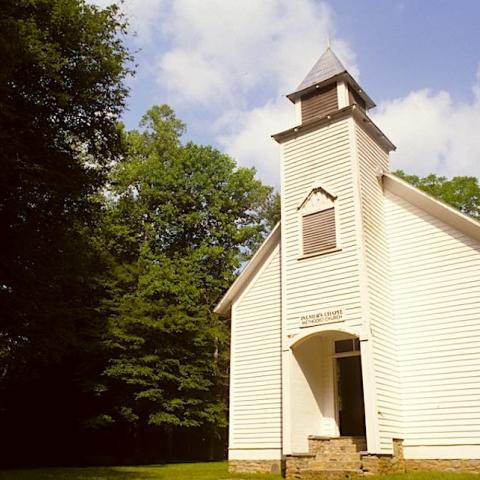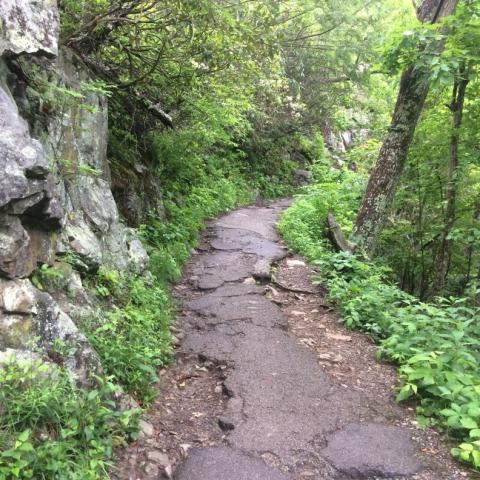Top Interior Department and National Park Service officials used Earth Day to promote the National Park System as an economic engine with an annual output of $30 billion and which serves as a carbon sink with an additional value of nearly $600 million.
The report, released at 6 a.m. Eastern on Wednesday, comes at the mid-point of National Park Week and as the National Park Service builds on its campaign to mark its centennial in August 2016.
Along with touting the economic value of the park system, a clutch of accompanying reports pointed to $26 million in improvements to parks from coast to coast, the president's "Every Kid in a Park" initiative that will see 4th graders this fall receive an annual parks pass, and the "Find Your Park" campaign to connect all Americans to the country's system of public parks and recreation lands.
In 2014, the National Park System received over 292 million recreation visits. NPS visitors spent $15.7 billion in local gateway regions (defined as communities within 60 miles of a park). The contribution of this spending to the national economy was 277 thousand jobs, $10.3 billion in labor income, $17.1 billion in value added, and $29.7 billion in output. The lodging sector saw the highest direct contributions with 48 thousand jobs and $4.8 billion in output directly contributed to local gateway economies nationally. The sector with the next greatest direct contributions was restaurants and bars, with 60 thousand jobs and $3.2 billion in output directly contributed to local gateway economies nationally.
In a prepared statement, Interior Secretary Sally Jewell said the economic data underscore that, 'Our national parks often serve as economic engines for local communities, drawing tourists from around the world who pump money into area stores, restaurants, hotels and more. At the same time, these treasured landscapes have shown they support strong public health by absorbing carbon pollution that contributes to climate change. When we invest in our parks, we're not only preserving our natural and historic sites, we're supporting strong economic growth and healthier communities.'
Gateway communities to the parks were a large benefactor of this spending, as motels and hotels in those communities received $9.5 billion in business from park visitors, while commercial campgrounds in those communities saw $922 million in business, according to the economic report.
The economic news was welcomed by the National Park Hospitality Association, which represents national park concessionaires.
'We applaud NPS efforts to describe the importance of park visits to regional and national economies ' it is significant, indeed," said Derrick Crandall, the association's counselor, in an email. "Even beyond the important figures contained in the report, national parks play an important role in prompting purchases of recreational equipment well beyond the 60-mile region around parks ' including major goods like RVs and boats and clothing. We also note that this report does not assess the value of our parks on inbound tourism to the United States ' a major and growing positive influence on our national economy.
'Best of all, the economic value of national parks to the nation can be enhanced without threats to the natural, cultural and historic resources of park units with management changes like longer operating hours and seasons and investment in appropriate visitor facilities designed to be low impact and efficient to operate.'
The news was also welcomed at the National Parks Conservation Association, where Craig Obey, the group's senior vice president for government, noted that, "It's clear that when our national parks are a priority, our economy benefits. The $3 billion increase in economic impact over 2013 is because more people visited parks, parks and communities didn't suffer the negative impact of a federal government shutdown, and the sequester cuts to parks were temporarily addressed.
'We had a record-breaking number of visits to national parks in 2014, and even more visits are likely with the approaching park centennial. This is the time to permanently end the sequester, reverse annual funding shortfalls, and fix park infrastructure with a pro-park transportation bill," he added in a prepared statement.
The report noted that its figures were best estimates based on various models, and that were likely over-estimated in some areas, and under-estimated in others.
As for parks serving as carbon dioxide sinks, the press release said, "Scientists found that 78 percent of the parks studied functioned as net carbon sinks, meaning that more CO2 is stored, or sequestered, than is released. Great Smoky Mountains National Park stored the largest amount of CO2, 1.6 million metric tons, valued at $64.4 million, each year."
"...in aggregate, NPS lands in the conterminous United States are a net carbon sink, sequestering more than 14.8 million metric tons of carbon dioxide annually. The associated societal value of this service is estimated at approximately $582.5 million per year," the report added.






 Support Essential Coverage of Essential Places
Support Essential Coverage of Essential Places







Comments
Scott,
What would you use to replace that water? Given the current drought conditions in CA and elsewhere in the west and the shortage of water exaserbated by inadequate reservoir storage, that doesn't seem like such a great idea.
EC -
You are correct it would be a colossally bad idea to go bust up the dam tomorrow. I was being very flippant and general in my response.
I would advocate for a well planned destruction of the reservoir that necessarily includes planning for the welfare of the people impacted. It also would necessarily include a more common sense approach to people living in such arid lands.
EC and Scott,
By all credible projections, there will never again be enough water to fill both Lake Powell and Lake Mead reservoirs, due to the impacts of climate change, reduced Colorado River flow, and rising demand for water. Glen Canyon Institute has proposed the Fill Mead First plan, which would designate Lake Mead as the primary water storage and distribution facility for the upper and lower Colorado River basins. Operation of Glen Canyon Dam would be changed to allow water to flow through as a run-of-river facility, filling Lake Mead reservoir before impounding water upstream in Lake Powell.
Fill Mead First would significantly reduce evaporation and seepage into the Lake Powell reservoir basin, saving or recovering 300,000 acre-feet or more of water per year. It would allow Glen Canyon to recover its natural integrity, allowing it to eventually be designated as a magnificent National Park. It would also benefit the Grand Canyon ecosystem, which is declining because 90 percent of life-giving sediment is being held back by Glen Canyon Dam. And it would store the water where it is needed, in Lake Mead, which supplies water to millions of people in Nevada, Arizona, and California — and holds water allocated to Mexico by international treaty.
With the growing impacts of climate change, Fill Mead First is already happening, without any change in water management policy. Dan Beard, former Commissioner of Reclamation says it is time to recognize the inevitable. He says we should acknowledge that building Glen Canyon Dam was a collossal mistake, and we should tear it down and restore a free-flowing river through Glen and Grand Canyons. His new book, Deadbeat Dams, makes the case for this strategy, as well the abolishment of the Bureau of Reclamation, which he argues is obsolete.
All of those projections have so far been completely incorrect. Poor water management practices, environmental policies and low rainfall are the problem.
Scott, it's the old professor in me, and I apologize. These days, I wouldn't last a day in a university. Simply, when you called my lecture a rant, well, I reverted to type. All of my lectures come to a conclusion that makes sense. You simply have to put down the smart phone and listen! I love The Traveler because people listen, and yes, for the most part intelligently respond. As for what is happening these days in universities, that is a lecture for another time.
You make excellent points, as well. And here is the point about Lake Mead--dam and all. It's beautiful. During the summer, I pass through there practically every week on my way to give lectures in Zion. It's blazing hot, but still beautiful. Those landscapes (especially the red rocks) are a gem. I can't get enough of seeing them, just as I can't get enough of the Mojave National Preserve and the great desert landscapes along historic Route 66.
Twenty years ago, we were right to expand our great desert parks, just as we are now wrong to forget the rest of the desert. I am not against wind and solar per se, but yes, they need to be sited carefully. Instead, we have Siemens and other companies this week taking out full-page ads in THE WALL STREET JOURNAL, informing us that concentrated solar and wind power are "good," because the land costs "out there" are so "reasonable." Again, I read between the lines. If the Interior Department were not leasing those lands so "reasonably," would wind and solar--as presently conceived--pencil out?
We already know the answer. No. That is why the "innovators" need the public lands and tax credits. That is why Interior does not call THESE lands "carbon dioxide sinks."
Every time my good friend Garrett Hardin was challenged in class (Biology and Human Ecology, UC Santa Barbara), he responded in this way: "What would you think of a man about to jump off the Empire State Building, assuring you he would invent a parachute on the way down?" He might well know the "invention" he needed, but could he pull it off in time?
That's us--promising ourselves the inventions, but can we pull enough of them off in time? And if we don't, what have we destroyed in the process? Why don't we simply wait and perfect the inventions before proceeding? We did that with the transcontinental railroads and the Space Program. We insisted the technology work. Then we gave the land grants and the government contracts. Only when the risk was reasonable did we take the risk.
What happened? Well, we have been discussing that, haven't we? These days, the politicians feel obligated to leave their mark on the fire hydrant, even when they have no pee. Look what I brought YOU! The point remains: It's our money they're spending. Those are our public lands.
Don't tell us that you see "carbon sinks," when what you really see is dollar signs. Kurt's editorial this morning says it all. And it's time we the public said it, too. You haven't given me a thing that I didn't already have. If you want to take credit for stealing it, at least be honest that your parachute might not open in time.
beachdumb,
Really? You left off the rest of my sentence: "due to the impacts of climate change, reduced Colorado River flow, and rising demand for water."
Even with the best management practices, the demand for water from the Colorado River has outstripped the supply. This is because the population has grown exponentially over the last half century. Better management can help, but not without a dramatic reduction in demand.
Most of the Colorado River's flow is from snowpack during the winter, not rainfall. The amount of snowpack has been decreasing and what does accumulate is melting sooner and losing more water to evaporation, because of the impacts of an unprecedented, 1,000-year drought, exacerbated by climate change.
As to projections being incorrect, maybe you have not seen the peer-reviewed paper published in 2008 by scientists at Scripps Institute of Oceanography, which predicted that Lake Mead could go dry by 2021, if existing trends continue. The continuing decline of Lakes Powell and Mead are consistent with this report's findings. Maybe you have not read the 2013 Colorado River Supply and Demand Study, which concluded that there is already a significant water deficit, and it is likely to rise to 3.2 million acre-feet by 2060. Since then, the trend is consistent with what they projected.
Perhaps you can share your sources of information that prove that these projections or the data they are based on to be incorrect, because I have not seen any.
Apparently not:
"Precipitation on the Colorado Plateau is biseasonal, having both winter and summer regimes (Hereford and others, 2002). In the headwaters, precipitation generally is evenly distributed across the four seasons, accumulating mostly in snowpacks."
http://pubs.usgs.gov/fs/2004/3062/
Best you go back and reread that report.
"being exhausted by a 14-year drought, unprecedented in the last 1,000 years"
The report claims a 14 year drought which has been unprecedented in 1000 years. Very different statements.
EC,
I do not see how your citation from Hereford, et al 2002 refutes what I wrote.
I do stand corrected for carelessly citing the statement in the WRA report. The quote, as you accurately cited it, is bad enough that it does not need any embellishment.